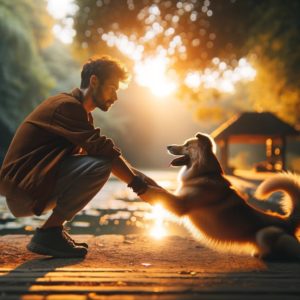The emotional lives of our pets are far richer and more complex than we once believed. Going beyond mere instinct or learned behavior, animals display behaviors that reflect their genuine emotional states. They exhibit a broad range of emotions – from joy and affection to fear and anxiety. Understanding these emotional responses is vital in deepening our bonds with our pets, providing them with the appropriate care and empathy they deserve.
Chapter 3: Emotional Responses vs. Instinctual and Learned Behaviors in Pets: Deepening Our Understanding
The Complexity of Animal Behavior
Our pets’ behaviors are more complex than they might initially seem. While it’s easy to see a dog barking at a stranger as a straightforward protective reaction or a cat responding excitedly to the sound of a can opener as a sign of learned behavior, there’s another layer that requires our attention: emotional responses. A dog whining during a thunderstorm or a cat hiding in the presence of a crowd are displaying emotional reactions – fear or anxiety. To truly understand our pets, it’s essential to distinguish between instinctual behaviors, learned behaviors, and emotional responses.
Unpacking Instinctual Behaviors
Instinctual behaviors are innate, automatic responses to specific stimuli that an animal exhibits without prior experience or training. These behaviors are hardwired into an animal’s genetic makeup and have evolved over generations for the sake of survival. A dog’s protective bark at a stranger is a perfect example of instinctual behavior. This barking response, driven by an innate desire to protect its territory or family, doesn’t require learning; it’s instinctively programmed into the dog’s behavior.
The Power of Learned Behaviors
In contrast to instinctual behaviors, learned behaviors are those that an animal acquires through interaction with its environment, often as a result of conditioning. For example, a cat responding to the sound of a can opener signifies a learned behavior. Over time, the cat has associated the noise of the can opener (a neutral stimulus) with being fed (a positive outcome), leading to an excited response whenever it hears the sound. This behavior isn’t genetically preprogrammed but arises from the cat’s experiences and learning.
Emotional Responses – Beyond Instincts and Learning
While instincts and learned behaviors heavily influence our pets’ actions, emotional responses bring a different facet to our understanding. These are not reactions that animals are born with or ones that they necessarily learn. Instead, they reflect the animals’ emotional states and can vary greatly depending on the situation. For example, a dog may whine during a thunderstorm or a cat may hide in the presence of a crowd, both indicative of fear or anxiety. These responses showcase their ability to feel and react emotionally to their environment.
Distinguishing Behaviors for Enhanced Understanding
Recognizing the difference between instinctual, learned, and emotional behaviors can dramatically enhance our understanding of our pets. Each type of behavior provides a different insight into our pets’ minds. Instinctual behaviors inform us about their innate survival tactics, learned behaviors reflect their adaptability and intelligence, while emotional responses reveal their capacity for feeling a range of emotions. By distinguishing between these, we can better interpret their actions and reactions, leading to more effective communication and stronger bonds with our pets.
A Comprehensive Understanding of Our Pets
Our pets are complex beings, capable of a range of behaviors influenced by instincts, learning, and emotions. Understanding this complexity can help us form more empathetic relationships with our pets, where we not only care for their physical needs but also respect their emotional experiences. By doing so, we can ensure their well-being and foster an enriching co-existence with our furry friends.







